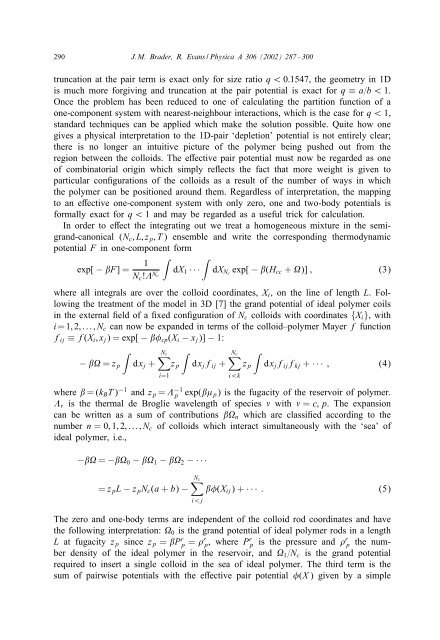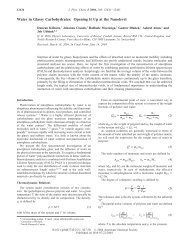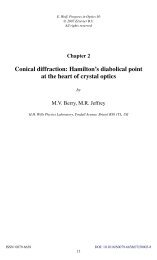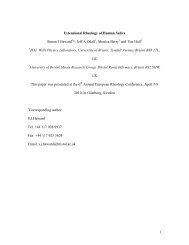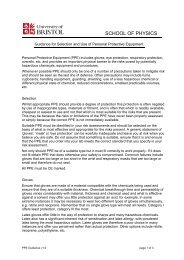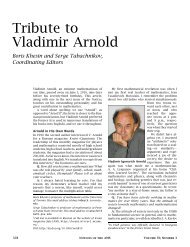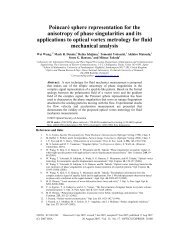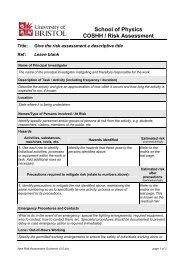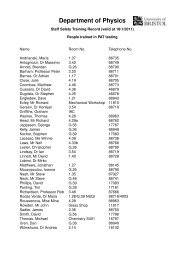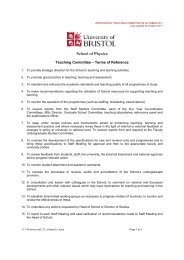An exactly solvable model for a colloidâpolymer ... - bristol.ac.uk
An exactly solvable model for a colloidâpolymer ... - bristol.ac.uk
An exactly solvable model for a colloidâpolymer ... - bristol.ac.uk
You also want an ePaper? Increase the reach of your titles
YUMPU automatically turns print PDFs into web optimized ePapers that Google loves.
290 J.M. Brader, R. Evans / Physica A 306 (2002) 287 – 300<br />
truncation at the pair term is ex<strong>ac</strong>t only <strong>for</strong> size ratio q¡0:1547, the geometry in 1D<br />
is much more <strong>for</strong>giving andtruncation at the pair potential is ex<strong>ac</strong>t <strong>for</strong> q ≡ a=b ¡ 1.<br />
Once the problem has been reduced to one of calculating the partition function of a<br />
one-component system with nearest-neighbour inter<strong>ac</strong>tions, which is the case <strong>for</strong> q¡1,<br />
standardtechniques can be appliedwhich make the solution possible. Quite how one<br />
gives a physical interpretation to the 1D-pair ‘depletion’ potential is not entirely clear;<br />
there is no longer an intuitive picture of the polymer being pushedout from the<br />
region between the colloids. The eective pair potential must now be regarded as one<br />
of combinatorial origin which simply reects the f<strong>ac</strong>t that more weight is given to<br />
particular congurations of the colloids as a result of the number of ways in which<br />
the polymer can be positionedaroundthem. Regardless of interpretation, the mapping<br />
to an eective one-component system with only zero, one andtwo-body potentials is<br />
<strong>for</strong>mally ex<strong>ac</strong>t <strong>for</strong> q¡1 andmay be regardedas a useful trick <strong>for</strong> calculation.<br />
In order to eect the integrating out we treat a homogeneous mixture in the semigrand-canonical<br />
(N c ;L;z p ;T) ensemble and write the corresponding thermodynamic<br />
potential F in one-component <strong>for</strong>m<br />
exp[ − F]= 1 ∫ ∫<br />
dX 1 ··· dX<br />
N c ! Nc<br />
Nc exp[ − (H cc + )] ; (3)<br />
where all integrals are over the colloidcoordinates, X i , on the line of length L. Following<br />
the treatment of the <strong>model</strong> in 3D [7] the grand potential of ideal polymer coils<br />
in the external eldof a xedconguration of N c colloids with coordinates {X i }, with<br />
i =1; 2;:::;N c can now be expanded in terms of the colloid–polymer Mayer f function<br />
f ij ≡ f(X i ;x j ) = exp[ − cp (X i − x j )] − 1:<br />
∫<br />
∑N c ∫<br />
∑N c ∫<br />
− = z p dx j + z p dx j f ij + z p dx j f ij f kj + ··· ; (4)<br />
i=1<br />
where =(k B T) −1 and z p = −1<br />
p exp( p ) is the fug<strong>ac</strong>ity of the reservoir of polymer.<br />
is the thermal de Broglie wavelength of species with = c; p. The expansion<br />
can be written as a sum of contributions n which are classied<strong>ac</strong>cording to the<br />
number n =0; 1; 2;:::;N c of colloids which inter<strong>ac</strong>t simultaneously with the ‘sea’ of<br />
ideal polymer, i.e.,<br />
− = − 0 − 1 − 2 −···<br />
i¡k<br />
∑N c<br />
= z p L − z p N c (a + b) − (X ij )+··· : (5)<br />
i¡j<br />
The zero and one-body terms are independent of the colloid rod coordinates and have<br />
the following interpretation: 0 is the grand potential of ideal polymer rods in a length<br />
L at fug<strong>ac</strong>ity z p since z p = Pp r = r p, where Pp r is the pressure and r p the number<br />
density of the ideal polymer in the reservoir, and 1 =N c is the grandpotential<br />
requiredto insert a single colloidin the sea of ideal polymer. The thirdterm is the<br />
sum of pairwise potentials with the eective pair potential (X ) given by a simple


